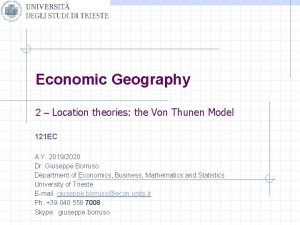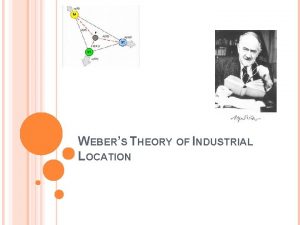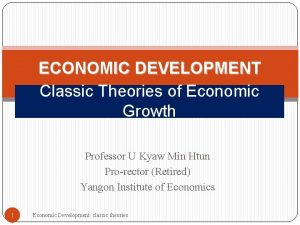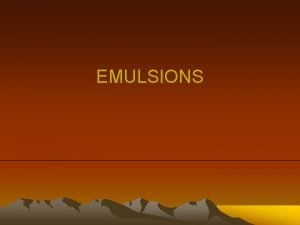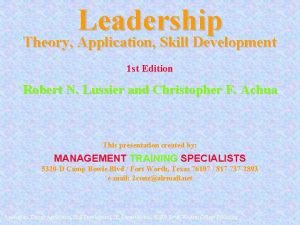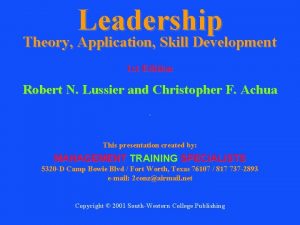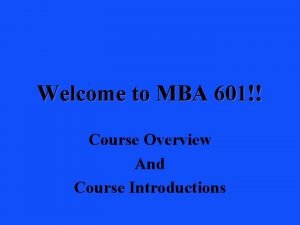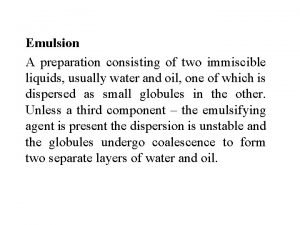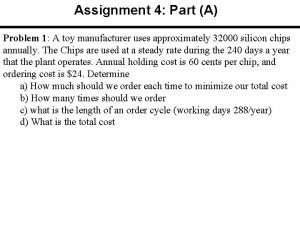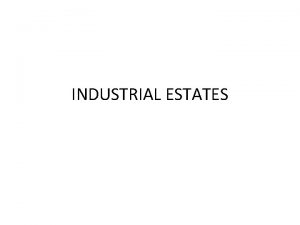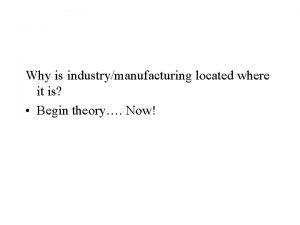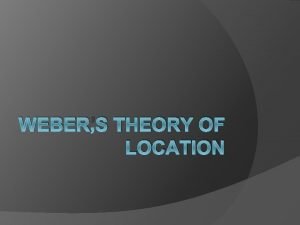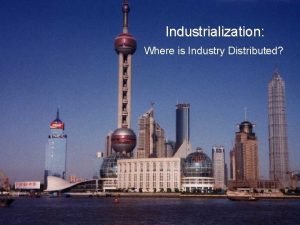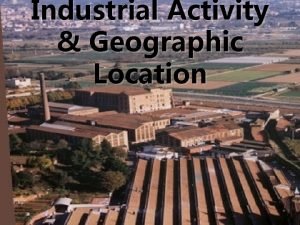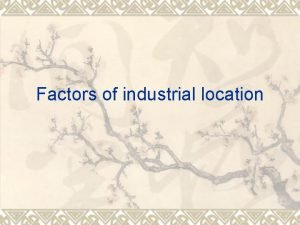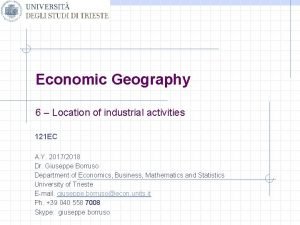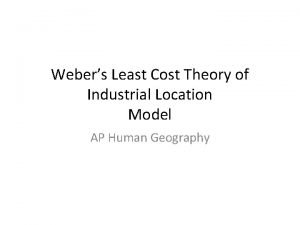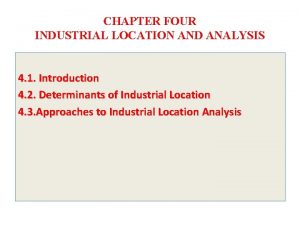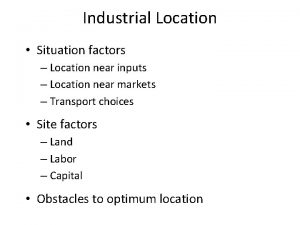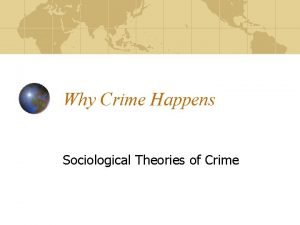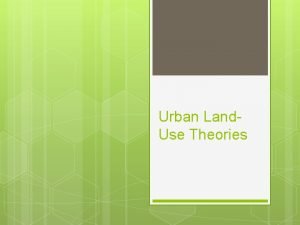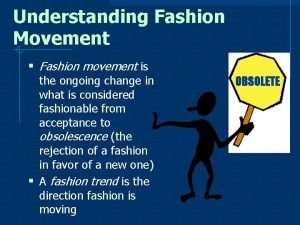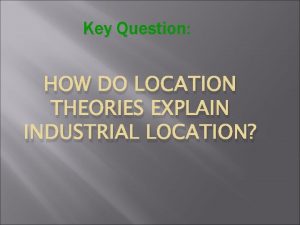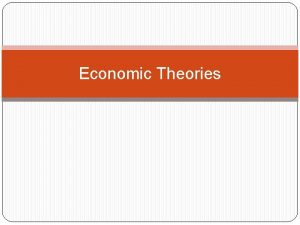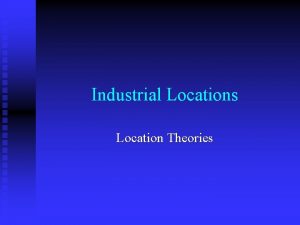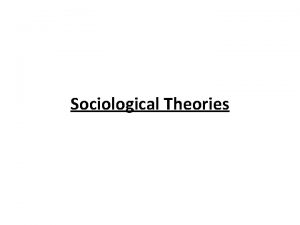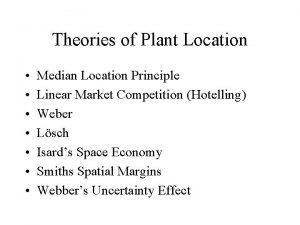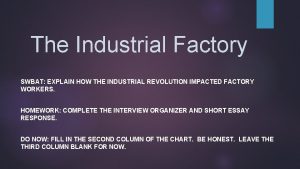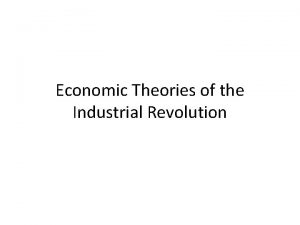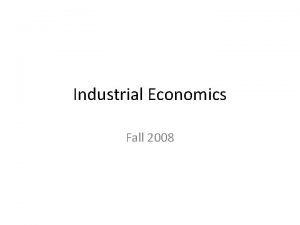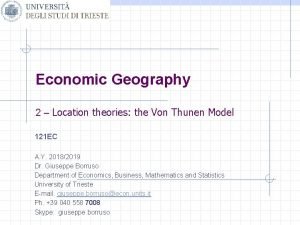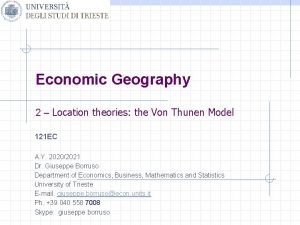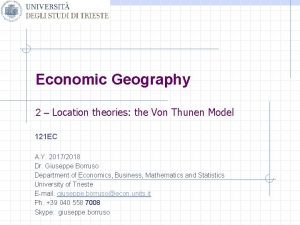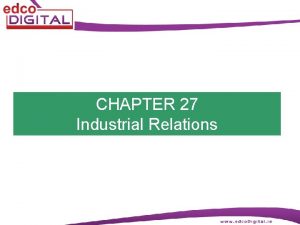How do Location Theories explain Industrial Location Economic































- Slides: 31

How do Location Theories explain Industrial Location?

Economic Geography • Economic geographers investigate the reasons behind the location of an economic activity

Location Theory • Attempts to explain the pattern of the location of an economic activity in terms of influential factors

The Location Decision • Alfred Weber: 1868 -1958 • Built on Von Thunen model of Agricultural Land Use • Least Cost Theory – Accounted for the location of a manufacturing plant in terms of the owner’s desire to maximize three costs • Transportation • Labor • Raw Materials

The Location Decision (1) q. Transportation (most important) qmoving raw materials to factory and finished goods to market

The Location Decision (2) q. Labor q. High labor costs reduce margin of profit q. Explains the current economic boom on Pacific rim q. Location chosen always has least combined costs (might have higher transportation costs, but more inexpensive labor)

Factors of Industrial Location (2) – Labor • a large, low-wage trainable labor force will attract manufacturers • Japan’s postwar success based on skills and low wages of workforce, low quality high quantity initially

Factors of Industrial Location (2) – Labor • China emerged with large labor force in 80’s • Taiwan and South Korea emerged to challenge Japan in mid ‘ 90’s due to cheaper labor • Four Tigers today (Hong Kong, Singapore, South Korea, Taiwan)

The Location Decision (3) • Raw Materials • Primary Industries – Because these deal with the extraction of resources, primary industries must be located where the resources are

The Location Decision • Secondary Industries – less dependent on resource location – raw materials can be transported if profits outweigh the costs of transportation

The Location Decision (3) q. Agglomeration qnumber of similar enterprises clustered in the same area q. Great example is car dealerships and fast food restaurants q. Shared talents, services and facilities qwhen excessive, can lead to high rents, rising wages, circulation problems


Weber Triangle • Three factors: – Transport costs – Labor costs – Raw Materials • Transport costs: – One market and two sources: • Equal distance and shipping costs dictates a market location • Two weight-losing materials results in an intermediate location

Weber’s Theory • Weber’s theory results in 3 generalizations: – Using pure materials in the production process will always dictate a market location – Weight-loss materials usage will pull the plant closer to the sources – Intermediate location chosen most often

Weber • Some argued that Weber’s model did not adequately account for variations in costs over time – Substitution principle: when one cost decreases can endure higher costs in another area (fixed vs variable costs) – Model suggests that one particular site (point vs area) would be optimal but the business could flourish in more than one area – Taxation policies are not accounted for by Weber


Factors of Industrial Location (1) – Raw Materials • resources involved in manufacturing • steel plants along Atlantic seaboard because iron shipped in from Venezuela • Europe’s coal and iron ore regions – Iron smelters built near coal fields


Factors of Industrial Location (1) – Raw Materials • Japan’s colonial expansion into E Asia (China/Korea) due to raw materials • Japan’s cheap labor allowed them to purchase and transport goods from other locales (substitution principle) • European colonization for resources, periphery to core

http: //www. epa. gov/sectors/sectorinfo/sectorprofiles/ironste el/map. html




Transportation Cost Minimization Raw Material Oriented Tendency for industry to locate near its source of raw materials in order to save on transport costs Usually occurs when raw materials lose weight in the production process (e. g. , paper, steel)

Transportation Cost Minimization Market Oriented Tendency for industry to locate near population centers in order to save on transport costs Occurs when product is more costly to transport than raw materials (e. g. , beverages, glass)

Transportation Cost Minimization Break-of-Bulk Oriented Location between sources of raw materials and markets – for products that must be divided and shipped from a central point of entry Intermodal transportation – e. g. , moving from rails to trucks or ships to trucks, or ports to pipelines

Where is the best location for a steel manufacturing plant? Recipe for steel (traditional) Coal = 2 to 3 tons (+ energy*) Iron ore = 1½ to 2 tons Limestone = ¼ to ½ ton Mix all solid ingredients. Heat at about 600º F until thoroughly melted. * Pour molten blend into molds. Cool and serve. Makes one ton of finished steel.

Shipbreaking industry, Bangladesh Shipbreaking yards in Bangladesh alone dismantle about 90 giant ships a year, mostly oil tankers, generating millions in revenue, employing tens of thousands, and providing a significant proportion of the iron and steel used by local industry. However, there is a dark side to the industry in which the workers must toil in extremely hazardous conditions that frequently lead to death or serious injury and which is tremendously harmful to the environment. . A majority of ships are built in South Korea and China, filling orders placed by Japan, the UK, the US, Norway, Singapore and Denmark. Until the 1970 s, shipbreaking was done in the countries of origin, using heavy machinery on salvage decks. But increasing environmental regulations and labour costs resulted in the transfer of this work -- first to Korea and Taiwan, and then to South Asia after the Asian Tigers upgraded away from this work. Source: www. sosarsenic. net

Consider transport costs of a car’s components. Where’s a good place to locate your assembly plant?

Other Location Models • Hotelling’s Model-Harold Hotelling (1895 -1973) this economist modified Weber’s theory by saying the location of an industry cannot be understood with out reference to other similar industriescalled Locational Interdependence • Lösch’s Model-August Losch said that manufacturing plants choose locations where they can maximize profit. • Theory: Zone of Profitability

Lösch’s Model-Zone of Profitability
 Von thunen location theory
Von thunen location theory Alfred weber's theory
Alfred weber's theory Dualistic development thesis
Dualistic development thesis Classify emulsifying agents
Classify emulsifying agents Behavioral leadership theories attempt to explain
Behavioral leadership theories attempt to explain Behavioral leadership theories attempt to explain
Behavioral leadership theories attempt to explain Behavioral leadership theories attempt to explain
Behavioral leadership theories attempt to explain Upward movement of the internal phase of emulsion
Upward movement of the internal phase of emulsion Economic growth vs economic development
Economic growth vs economic development Economic growth vs economic development
Economic growth vs economic development Economics unit 1 lesson 2 difficult choices
Economics unit 1 lesson 2 difficult choices 32000/240
32000/240 Define “industrial estates”.
Define “industrial estates”. Industrial estates definition
Industrial estates definition Saudi arabia location on the economic continuum
Saudi arabia location on the economic continuum Least cost theory
Least cost theory Isotim and isodapane
Isotim and isodapane St. petersburg industrial district location
St. petersburg industrial district location Weber's model of industrial location
Weber's model of industrial location Factors of industrial location
Factors of industrial location Isotims
Isotims Weber's least cost theory ap human geography
Weber's least cost theory ap human geography Tord palander theory of industrial location
Tord palander theory of industrial location Bulk gaining examples
Bulk gaining examples A cross country skier moves from location a to location b
A cross country skier moves from location a to location b Location planning and analysis
Location planning and analysis Sociological theory of crime
Sociological theory of crime Psychodynamic theory
Psychodynamic theory Theories and values of positive practice
Theories and values of positive practice Burgess model of land use
Burgess model of land use Pass the proton acid-base theories answer key
Pass the proton acid-base theories answer key Flop fashion cycle examples
Flop fashion cycle examples
